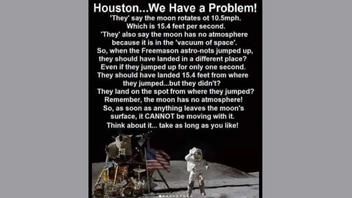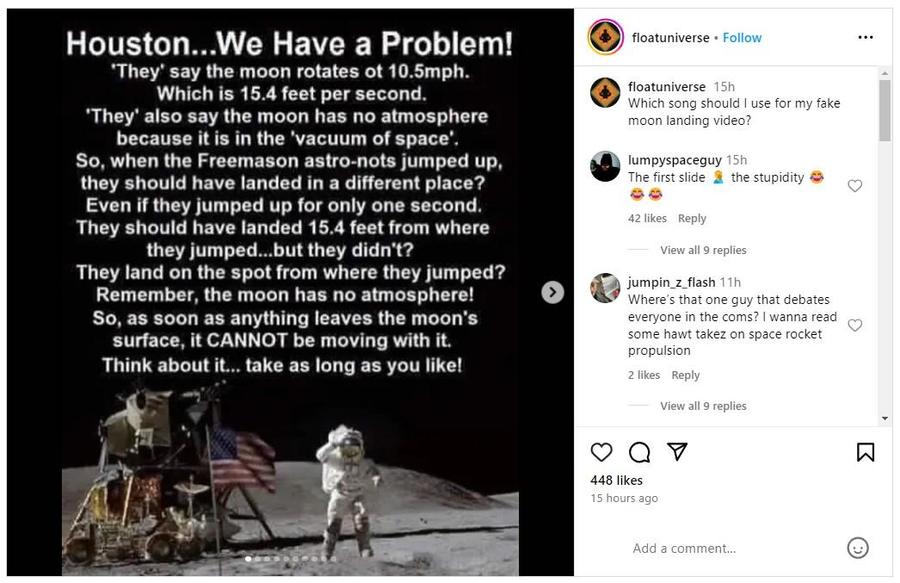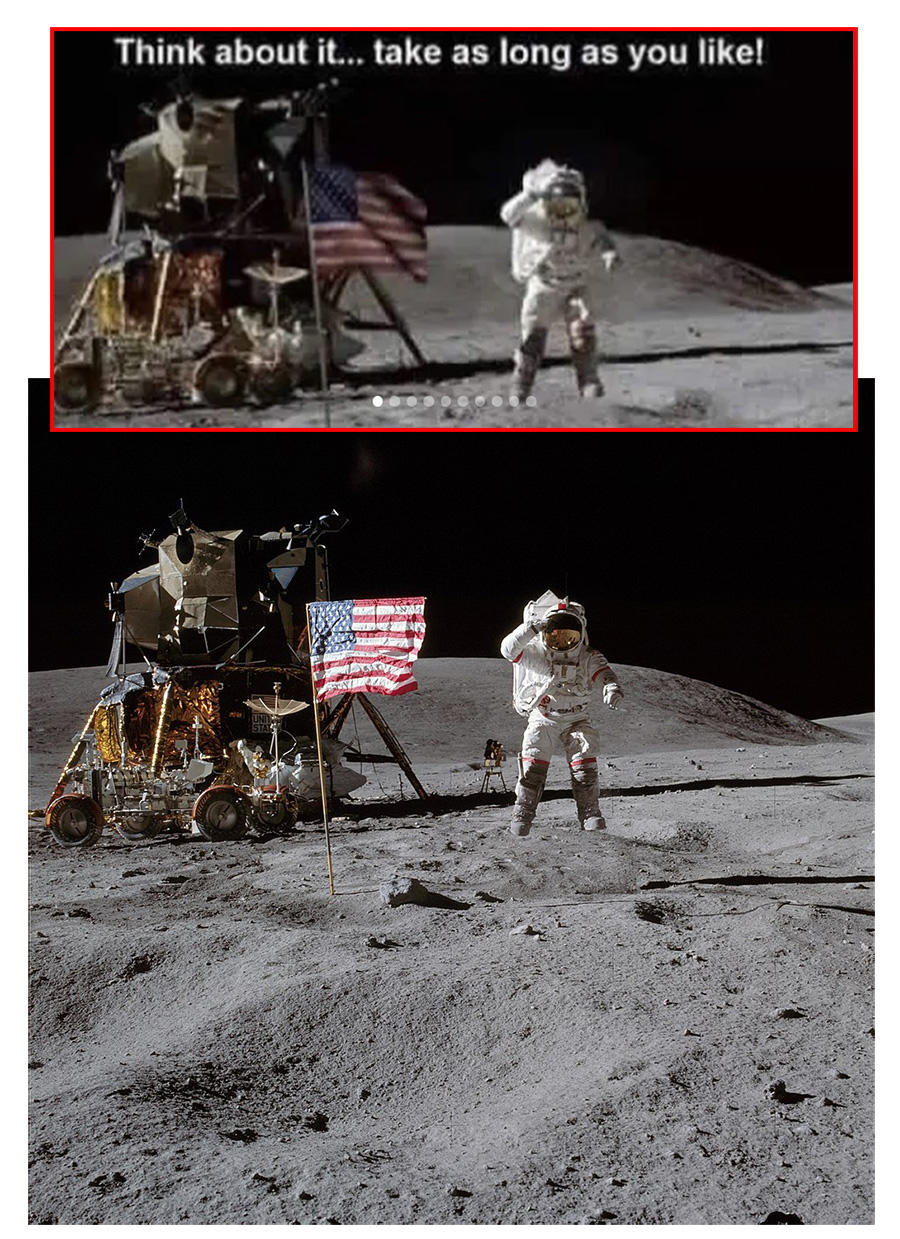
Does a meme on social media prove that footage of astronauts jumping on the surface of the moon must be fake because they come back down to approximately the same place? Wouldn't an astronaut who jumped up for one second come down many feet away from where he took off because the moon is rotating and has no atmosphere? No, that's not true: Regardless of how thin the moon's atmosphere is, the laws of motion described by Sir Isaac Newton over 300 years ago are just as true today on the moon and on Earth.
Newton's first law states: "An object at rest remains at rest, and an object in motion remains in motion at constant speed and in a straight line unless acted on by an unbalanced force." An astronaut on the surface of the moon is moving with the speed of the moon's rotation and orbit. Jumping up momentarily would not cancel out the inertia.
The claim appeared in a post (archived here) on Instagram by @floatuniverse on February 27, 2024. It was captioned:
Which song should I use for my fake moon landing video?
The text on the meme reads:
Houston...We Have a Problem!
'They' say the moon rotates ot 10.5mph. Which is 15.4 feet per second. 'They' also say the moon has no atmosphere because it is in the 'vacuum of space'. So, when the Freemason astro-nots jumped up, they should have landed in a different place? Even if they jumped up for only one second. They should have landed 15.4 feet from where they jumped...but they didn't? They land on the spot from where they jumped? Remember, the moon has no atmosphere! So, as soon as anything leaves the moon's surface, it CANNOT be moving with it. Think about it... take as long as you like!
(Source: Instagram screenshot taken on Wed Feb 28 14:35:09 2024 UTC)
The Instagram post has a carousel of 10 memes on the theme of space program denial. This fact check will focus on the first meme (pictured above).
The specifics in the set-up of this meme are not crucial to the point the author is trying to make. However, for the record -- "They," whoever they are, aren't really saying the moon rotates at 10.5 mph. A Google search for the exact phrase "The moon rotates at 10.5 mph" (archived here) only brings up one result, a YouTube short with the text of this meme superimposed over scenes from the cartoon "Family Guy."
Lead Stories reached out by email to the Department of Physics and Astronomy at the University of Iowa to ask about the set-up in this meme: If an astronaut jumps up, would they come down on another spot on the moon? Kory Stiffler, a theoretical physicist and associate professor of instruction, responded by email on February 29, 2024. He explained:
This is Newton's First law, the pertinent part of which I am sure you have heard before: an object in motion continues in motion. This means when someone jumps up on the Earth, the Moon, Pluto, wherever, they continue moving as they were before. No push necessary, the default is that things keep going. So as the Earth is moving, the person continues moving with it even after they jump. The atmosphere does not push the person forward, rather, the person and atmosphere independently continue to move with the Earth. The moon is moving, so the person continues to move with it even after they jump, no push necessary. So everything on a planet or moon moves with the planet or moon, regardless of the motion of the planet or moon. Galileo is often credited as the first to clear this up from the old Aristotle (4th century BCE) way of viewing things, which assumed because of observations similar to yours, that the Earth could not be moving. About 2000 years after Aristotle, Galileo invoked what later became known as Newton's first law, demonstrating that the Earth can move, things just move with it, the same as the moon, or anything else. Again, no push necessary, the default is that things keep moving, a property known as inertia.
We also reached out to Mark Moldwin, a professor of space sciences at the University of Michigan, with the same question. Moldwin replied by email on February 28, 2024:
Simple answer is that when you are standing on the moon you have the same rotational velocity as the moon's surface so you have a velocity component in the same direction as the moon is rotating and hence will land in the same spot jumping up and down.
The moon rotates once each time it orbits Earth. An animation of this synchronous rotation over the period of just over 27 days can be found (here) on the NASA website. As pointed out by Moldwin, the speed of rotation varies depending if it was measured at the equator or the poles. The imprecise specific details of rotational speed included in the meme are a distraction from the flawed premise.
In 1687 Newton described three laws of motion that hold true to this day on Earth and on the moon with very few exceptions.
- A body remains at rest, or in motion at a constant speed in a straight line, except insofar as it is acted upon by a force.
- The net force on a body is equal to the body's acceleration multiplied by its mass or, equivalently, the rate at which the body's momentum changes with time.
- If two bodies exert forces on each other, these forces have the same magnitude but opposite directions.
The iconic image used in the meme shows astronaut John Young on the Apollo 16 mission. Motion picture footage of Young's jump and salute and from a different angle as it was being photographed is posted here on the NASA YouTube channel. The meme image (pictured below with a red border) has been subtly edited from the original to support conspiracy narratives. A small piece of equipment in the background is absent, and importantly, the American flag, which was fitted with a rigid horizontal bar so it could "fly" under the mission's lunar conditions, has been replaced with a flying flag that lacks the rigid support bar. Young's shadow, which shows that his feet are not touching the moon's surface in the original photo, has been cropped away entirely. The public domain image is captioned:
John W. Young on the Moon during Apollo 16 mission jumping about 42 Centimeters high. Charles M. Duke Jr. took this picture. The LM Orion is on the left. April 21, 1972
(Source: Lead Stories composite image with Instagram and Wikipedia screenshot images taken on Fri Mar 01 00:29:44 2024 UTC)



















